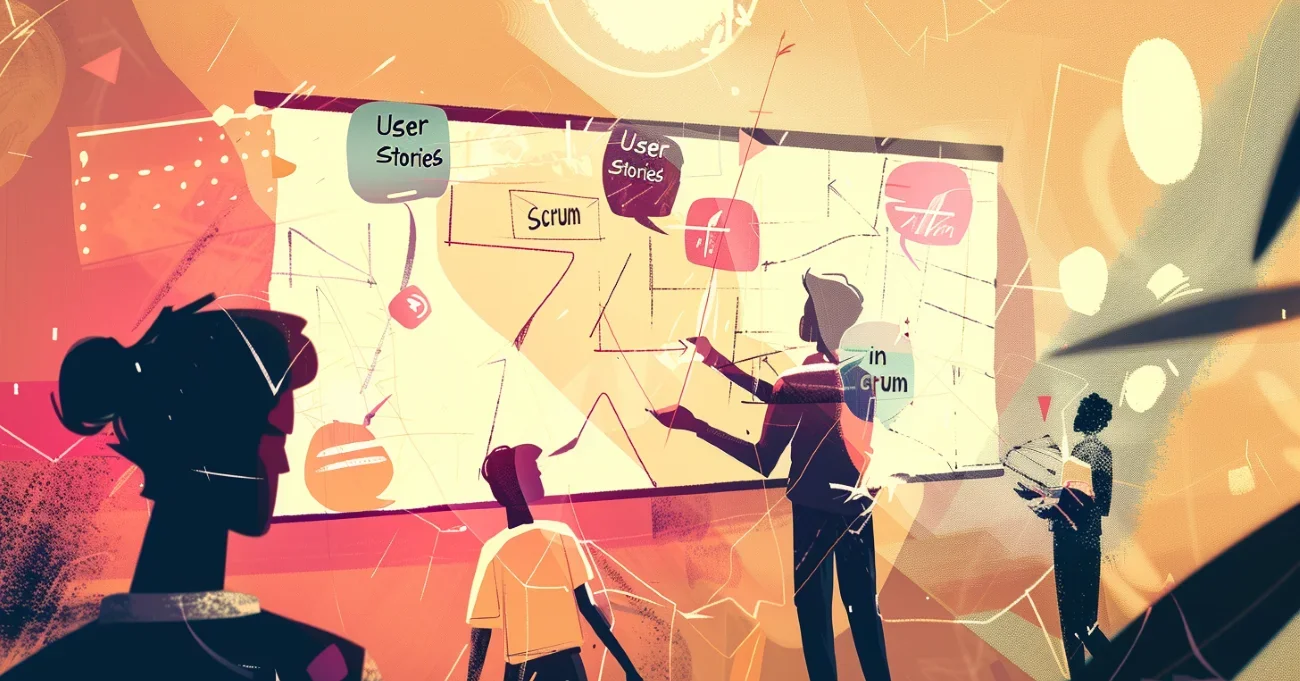In software development, user stories are crucial in the Scrum framework, the cornerstone for successful project outcomes. While it might seem straightforward, determining who creates user stories in Scrum is a nuanced process that involves collaboration across roles, from the product owner to the team members, ensuring every story aligns with the business value and the stakeholders' expectations.
Aloa, an expert in software outsourcing, leverages its extensive experience to assist businesses and startups in crafting compelling user stories. Through their deep understanding of the Agile methodology, Aloa empowers teams to navigate the complexities of backlog refinement and sprint planning and ensures that every task aligns with the business value. Their expertise extends to facilitating seamless collaboration among the product owner, the development team, and stakeholders, ensuring that every user story reflects the needs and aspirations of the end users.
This blog will delve deep into who creates user stories in Scrum, understanding the importance of roles. We will explore the process of creating a user story for Scrum and provide a compelling job ad template. Afterward, you will gain insights into the benefits of working with the product owner in drafting the user stories, ensuring their Scrum team can navigate task and product backlog management effectively.
Let's dive in!
What is a User Story in Scrum?
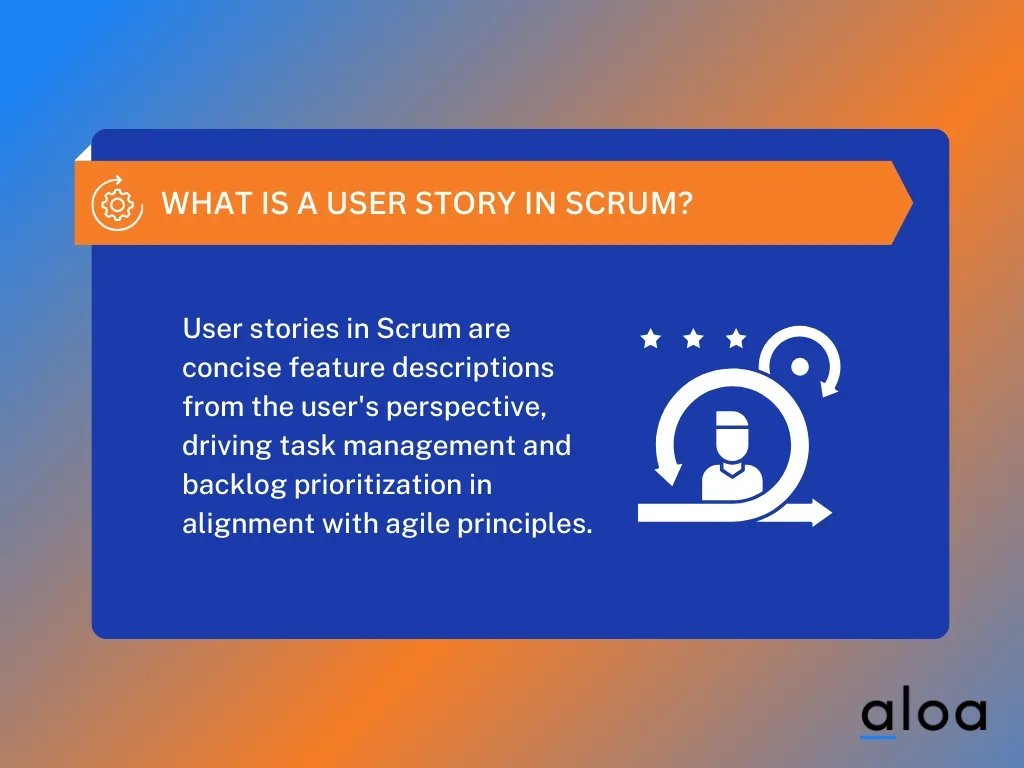
A user story in Scrum is a simple, concise statement that describes a feature or requirement from an end-user's perspective. It plays a critical role in Agile and Scrum methodologies, ensuring that the development work focuses on the users' needs and delivers value. The components of a user story include:
- Title: A brief, descriptive summary of the feature or need.
- User Role: The identity of the end-user or customer.
- Desired Action: What the user wants to do or achieve.
- Goal/Benefit: The value or outcome the user seeks.
Incorporating user stories into the Scrum framework facilitates task management, aligns backlog items with the Minimum Viable Product (MVP), and helps prioritize the sprint backlog. User stories, often recorded on index cards or digital platforms, serve as placeholders for conversation and confirmation, embodying Scrum artifacts and the essence of the agile environment.
Who Creates User Stories in Scrum?
In Agile development, understanding who creates user stories in Scrum is crucial for the seamless execution of projects. User stories form the backbone of the Scrum framework, translating complex requirements into simple, user-centric tasks. They are crucial in encapsulating the needs and expectations of the end-user.
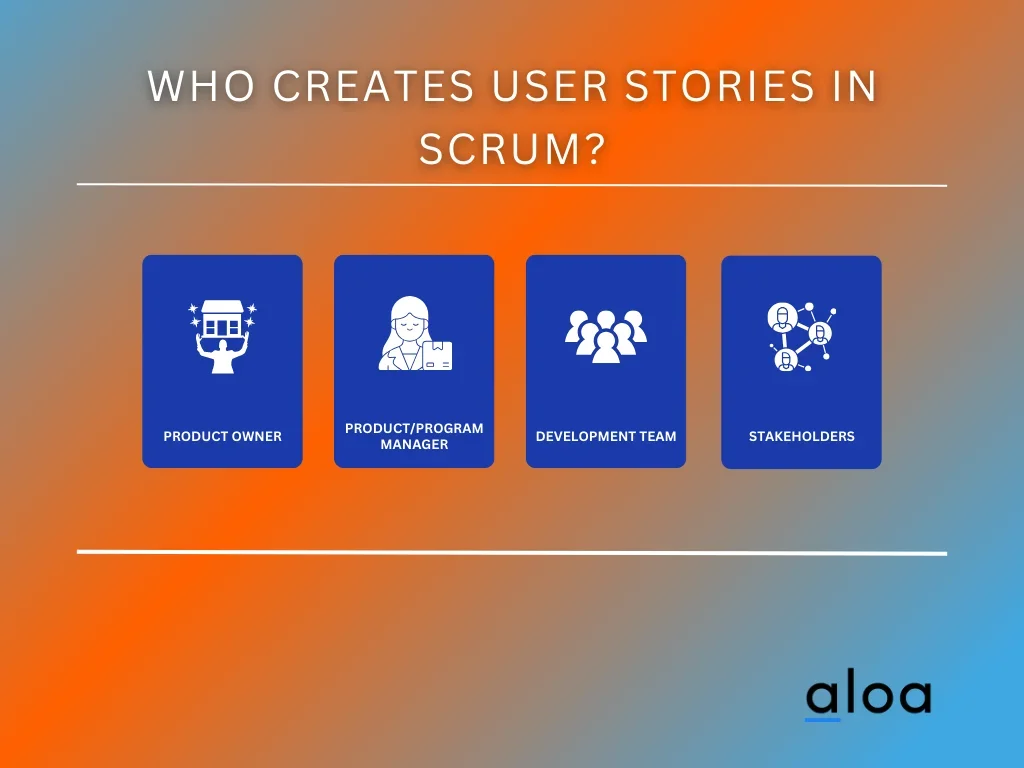
Product Owner
A certified Scrum Master, the Product Owner (PO) stands at the forefront of user story creation. They champion the product's vision and act on the stakeholders' behalf. Their responsibility lies in deciphering stakeholder requirements and translating them into tangible user stories. The PO, who creates user stories in Scrum, prioritizes within the product backlog, ensuring alignment with the overarching goals and vision.
Product Manager / Program Manager
While only sometimes a formal role within Scrum, a product manager or program manager may contribute to user story creation, especially in larger organizations or projects. Their input often stems from a broader strategic perspective, aligning user stories with organizational objectives and market demands.
Development Team
The team, including developers, testers, designers, and other relevant members, collaborates closely with the Product Owner to refine and elaborate on user stories. This collaborative effort ensures that user stories are comprehensive, technically feasible, and aligned with the team's capabilities. Development team members contribute by providing insights into effort estimation, technical feasibility, and identifying potential dependencies or risks.
Stakeholders
Stakeholders play a crucial role in shaping user stories by providing valuable input and feedback. While they may not directly create user stories, their perspectives are instrumental in ensuring that the stories accurately capture the needs and requirements of end-users and the business. Regular feedback loops involving stakeholders help refine and iterate on user stories throughout the development process.
How To Create a Thorough User Story for Scrum
Crafting comprehensive user stories is crucial for effective Scrum development. In five key steps, teams can ensure clarity, alignment, and value delivery. Following these steps, teams can streamline processes, enhance collaboration, and deliver products that meet user needs within the Scrum framework.
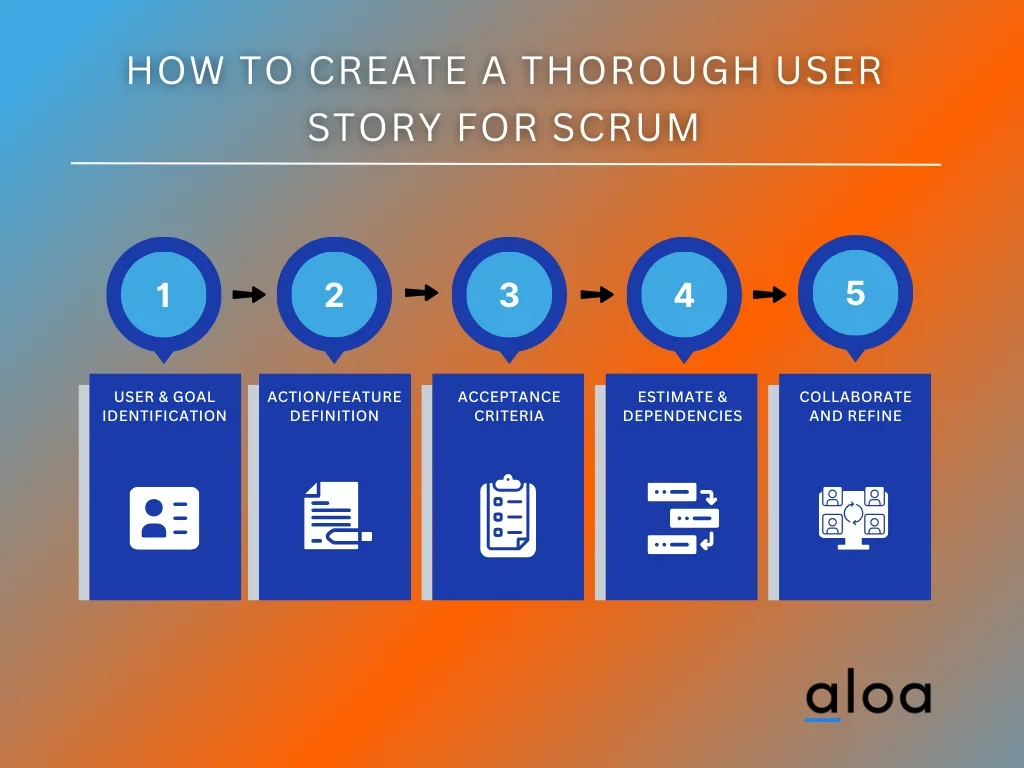
Step 1: Identify the User and Their Goal
To create a thorough user story in Scrum, it's essential to identify the user and understand their objectives clearly. This sets the foundation for developing features directly addressing user needs and preferences. Below are the key questions to ponder in this step.
- Who is the user? Determine the specific demographic or role of the user in the story.
- What is their goal? Clearly define what the user aims to achieve by interacting with the system or product.
- Why is this goal important? Understand the underlying motivations driving the user's actions.
- Are there any constraints or limitations? Consider any factors impacting the user's ability to accomplish their goal.
- How does this align with overall project objectives? Ensure that the user's goal aligns with the broader goals of the project and business.
Addressing these fundamental questions, the team can understand the user and their needs comprehensively, guiding the creation of user stories that deliver tangible value. This collaborative effort involving the Product Owner, development team, and stakeholders ensures that user stories accurately reflect user requirements and drive the development process forward effectively.
Step 2: Define the Action or Feature
This step focuses on defining the specific action or feature that fulfills the user's goal, a crucial aspect of creating user stories in Scrum. To create a user story, it's essential to clearly articulate the action or feature required to meet the user's needs. This ensures a targeted approach to development and helps prioritize tasks effectively. Here are the things that must be considered:
- Identify key functionalities necessary for user satisfaction.
- Ensure the action or feature aligns with the overall product vision.
- Keep the description concise and focused on the user's primary objective.
- Consider any potential variations or edge cases impacting the feature's implementation.
- Collaborate with the development team to ensure feasibility and alignment with technical capabilities.
Meticulously defining the action or feature who creates user stories in Scrum lays the groundwork for a focused and productive development process. This clarity ensures that the development team understands precisely what needs to be built to meet the user's requirements and deliver value within the iteration.
Step 3: Specify Acceptance Criteria
Specifying acceptance criteria ensures that user stories meet the users' needs and are successfully implemented within the Scrum framework. It clearly defines what constitutes a complete and satisfactory outcome for the user story. Here are the criteria to consider:

- Clarity and Specificity: Acceptance criteria should be clear, specific, and unambiguous, leaving no room for interpretation.
- Relevance to User Needs: Ensure that the acceptance criteria directly address the user's goals and requirements outlined in the user story.
- Testability: Each criterion should be testable, allowing the development team to verify whether the functionality meets the specified conditions.
- Completeness: Include all necessary conditions to fully define the desired behavior and functionality of the user story.
- Alignment with Business Objectives: Ensure that the acceptance criteria align with the broader objectives of the project and contribute to the overall value delivered to the stakeholders.
Specifying acceptance criteria in collaboration with the Product Owner, who creates user stories in Scrum, ensures that the development team understands the expected outcomes clearly. Defining these criteria upfront, the team can prioritize tasks, plan their work, and deliver high-quality solutions that meet user expectations.
Step 4: Estimate Effort and Dependencies
Estimating effort and dependencies is critical for successfully implementing user stories in Scrum. The Product Owner, who creates user stories in Scrum, collaborates with the development team to assess the effort required for each user story. This involves considering complexity, technical requirements, and integration with existing systems. Thoroughly understanding the scope of work, the team can allocate resources effectively and ensure that the user story can be completed within the iteration.
Additionally, identifying dependencies on other tasks or features is essential to prevent bottlenecks and delays in the development process. The Product Owner works closely with the team to identify any dependencies that may impact the implementation of the user story. This proactive approach enables the team to address dependencies early by prioritizing related tasks or coordinating with other teams or stakeholders. Estimating effort and dependencies accurately, the team can plan their work effectively and deliver high-quality results within the Scrum framework.
Step 5: Collaborate and Refine
Collaboration and refinement of user stories are pivotal in the Scrum framework to ensure the development process remains aligned with stakeholder needs and evolving project dynamics. The Product Owner, who creates user stories in Scrum, initiates this phase by engaging with the development team and stakeholders. Together, they review the user stories to clarify requirements, validate assumptions, and adjust acceptance criteria. This collaborative effort fosters a shared understanding of the user stories among all team members, promoting transparency and reducing the likelihood of misinterpretation.
Moreover, refining user stories often involves breaking down large stories into smaller, more manageable tasks, facilitating incremental progress and efficient resource allocation. Continually refining user stories throughout the development cycle, the team can respond effectively to changing priorities and emerging insights, ensuring that the product evolves in line with user needs and business objectives. Thus, collaboration and refinement are cornerstones for delivering successful outcomes in Scrum projects.
Job Ad Template
Crafting effective job ads for the Scrum team role who creates user stories in Scrum requires clarity and conciseness. Each section, from job description to how to apply, plays a crucial role in attracting suitable candidates.
- Job Description: This section outlines the role's essential aspects. It includes responsibilities, required skills, and how to apply.
- Responsibilities: Detailing duties pertinent to the position, such as collaborating with stakeholders and creating user stories in Scrum. The Product Owner takes the lead, ensuring alignment with stakeholder needs and prioritizing backlog items effectively.
- Skills and Qualifications: Lists essential attributes like communication prowess and agile expertise in Scrum for effective user story creation. Proficiency in facilitating meetings and eliciting requirements is also valuable.
- How to Apply: Provides instructions for submitting applications, ensuring candidates know the process for expressing interest in the role. This includes details such as where to send resumes and any specific requirements for the application process.
Sample Job Ad Template
In the Agile framework, specifically within Scrum, understanding who creates user stories is pivotal for successful project outcomes. This job ad template is designed for a Product Owner, a key figure in Scrum teams, emphasizing their critical role in user story creation.
Job Description
We are seeking a proactive and skilled Product Owner to join our dynamic Scrum team, focusing on the pivotal role of creating user stories. The ideal candidate will play a crucial part in bridging the gap between user needs and the technical capabilities of our development team, ensuring that our projects are user-centered and feasible. Understanding who creates user stories in Scrum is vital for this position, as it requires deep involvement in the product backlog management and refinement processes.
Responsibilities
- Collaborate with stakeholders to gather and define user requirements, embodying the principle of who creates user stories in Scrum.
- Lead the creation and prioritization of user stories, ensuring they are clear, concise, and aligned with project goals.
- Work closely with the development team to clarify requirements, as the key user needs a communicator.
- Refine and maintain the product backlog, incorporating feedback and updates to user stories as needed.
- Facilitate Scrum events such as sprint planning, reviews, and retrospectives, focusing on continuously improving user story creation.
- Monitor project progress and adjust user stories and priorities to meet changing needs and deadlines.
Skills and Qualifications
- Strong understanding of Scrum methodologies and the role of the product owner in creating user stories.
- Excellent communication and collaboration skills, with the ability to engage effectively with stakeholders and team members.
- Experience in product backlog management and agile planning tools.
- Proven ability to write clear and measurable user stories that drive team focus and productivity.
- Analytical mindset with the capability to solve complex problems and prioritize tasks.
- Bachelor's degree in Computer Science, Business, or related field, or equivalent practical experience.
How to Apply
Interested candidates who are passionate about creating user stories in Scrum and meet the above qualifications are encouraged to submit their resumes and cover letters detailing their experience with creating user stories in Scrum. Join our team and contribute to our success by ensuring our products meet the needs of our users through effective user story creation.
Benefits of Working with the Product Owner in Drafting the User Stories
In the agile framework of Scrum, creating user stories is a pivotal aspect of the development process. Understanding who creates user stories in Scrum is crucial for ensuring clarity, alignment, and effectiveness within the development cycle. Let's explore five key advantages:
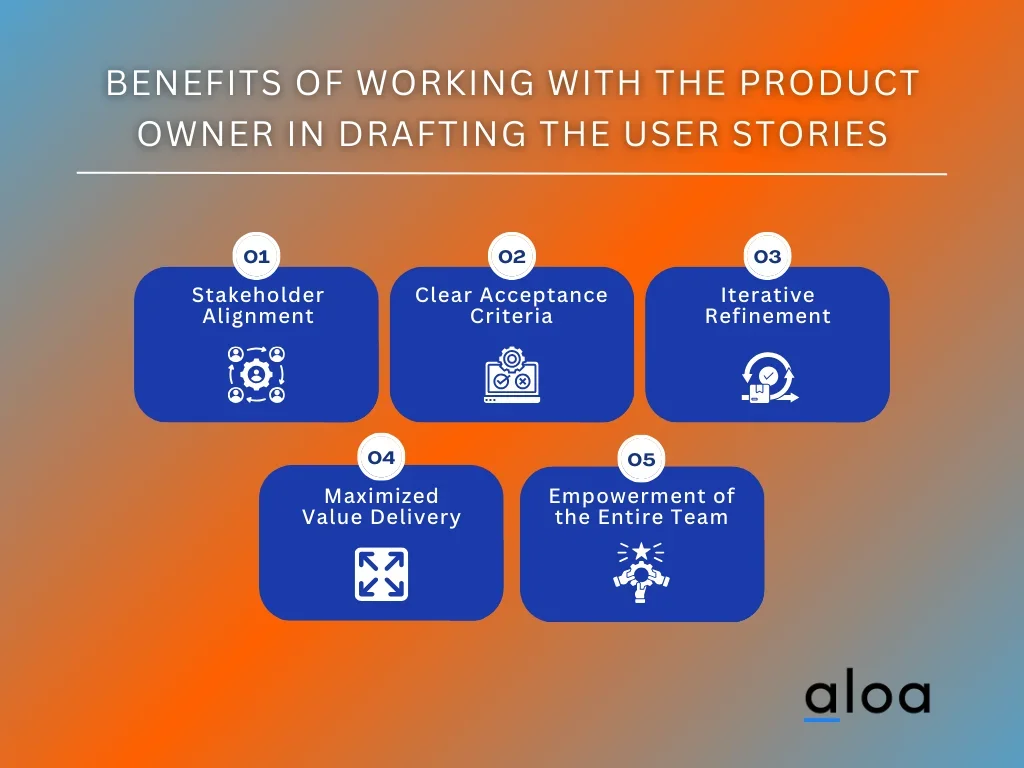
Alignment with Stakeholder Needs
Collaborating with the Product Owner ensures that user stories are created on behalf of the stakeholders. Actively involving the Product Owner, who creates user stories in Scrum, the team can better understand and incorporate the requirements, preferences, and priorities of the end-users and the business. This alignment helps deliver valuable functionality that meets the stakeholders' expectations.
Clear Definition of Acceptance Criteria
Working closely with the Product Owner facilitates the establishment of clear acceptance criteria for each user story. Acceptance criteria define the conditions that must be met for a user story to be considered complete and satisfactory. Discussing and refining these criteria, the PO, who creates user stories in Scrum, and the team ensure a shared understanding of the expectations, reducing ambiguity and misunderstandings during development.
Iterative Refinement
The iterative nature of Scrum allows for the continuous refinement of user stories throughout the development cycle. Collaborating with the Product Owner enables the team to incorporate feedback, insights, and changes from stakeholders as the project progresses. This iterative refinement ensures that user stories remain relevant, prioritized, and aligned with the evolving needs of the users and the business.
Maximized Value Delivery
Actively involving the Product Owner in creating user stories, the team can prioritize and sequence them based on their value to the stakeholders. With their deep understanding of the market, customer needs, and business objectives, the Product Owner can prioritize user stories to maximize the value delivered with each iteration who creates user stories in Scrum. This focus on value helps optimize the return on investment and enhance the project's overall success.
Empowerment of the Entire Team
While the Product Owner leads in drafting user stories, collaboration with the entire team is essential for ensuring their success. Involving developers, designers, testers, and other team members in creating promotes a shared product backlog ownership. This empowerment fosters a sense of accountability, engagement, and collaboration, leading to higher-quality deliverables and improved team dynamics.
Key Takeaway
Understanding who creates user stories in Scrum is crucial for successful project management. Typically, the product owner plays a pivotal role, but it's a collaborative effort involving the entire team. Focusing on creating compelling user stories, Scrum projects can achieve better clarity and direction, enhancing both productivity and product quality. Emphasizing the importance of this process encourages teams to invest time in crafting stories that accurately reflect user needs and project goals.
Creating compelling user stories in Scrum demands a deep understanding of the end user's needs and expectations. It's a strategic process that involves the entire team, led by the product owner, to ensure that every story precisely captures the essence of what the user desires and the value it will bring. This meticulous approach helps prioritize features, plan sprints more efficiently, and foster a user-centric development environment.
Explore Aloa blogs for insights on diving deeper into these topics. This can give you a broader understanding and improved practices for your projects, emphasizing the significance of knowing who creates user stories in Scrum.

